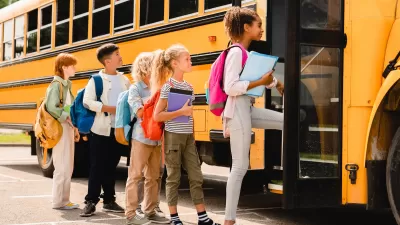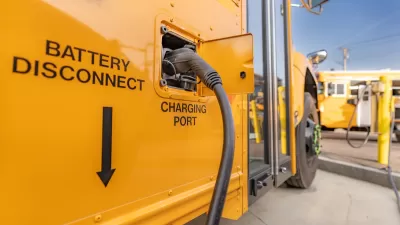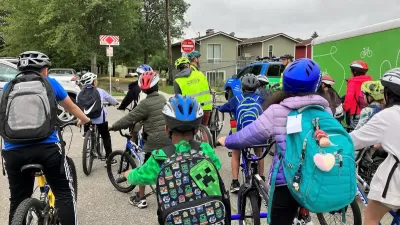As the economy has improved, fewer people are looking for employment as school bus drivers. When fewer buses are available, more students drive to school, brining unwanted environmental risks along for the ride.

An interactive feature in The Wall Street Journal examines the challenges created by a shortage of school bus drivers all over the country.
The effects of Wake County, North Carolina's school bus driver shortage, as an example, are obvious, writes story author Valerie Bauerlein:
In the last three years, Wake County has cut one in five bus routes, bumped children off the bus who live within a mile of their school, required others to walk further to the bus stop, and now is considering starting some schools earlier in the morning.
Wake County's driver shortage has grown into a crisis as the fast growing county has added 160,000 pupils in the last decade (a growth rate of 25 percent), while the number of bus drivers has declined by 18 percent.
The problem isn't unique to Wake County, however. "Roughly 90% of 231 school districts in a School Bus Fleet magazine survey last fall said they were short on drivers," according to Bauerlein. School districts are having a hard time competing in the labor market as wages rise and unemployment drops around the country.
The article includes high quality images, audio clips, and a lot of personal testimony to explain and illustrate the scale of the school bus driver challenge facing the nation's school system.
FULL STORY: Schools Wrack Their Brains as Bus Driver Jobs Go Begging

Alabama: Trump Terminates Settlements for Black Communities Harmed By Raw Sewage
Trump deemed the landmark civil rights agreement “illegal DEI and environmental justice policy.”

Planetizen Federal Action Tracker
A weekly monitor of how Trump’s orders and actions are impacting planners and planning in America.

The 120 Year Old Tiny Home Villages That Sheltered San Francisco’s Earthquake Refugees
More than a century ago, San Francisco mobilized to house thousands of residents displaced by the 1906 earthquake. Could their strategy offer a model for the present?

In Both Crashes and Crime, Public Transportation is Far Safer than Driving
Contrary to popular assumptions, public transportation has far lower crash and crime rates than automobile travel. For safer communities, improve and encourage transit travel.

Report: Zoning Reforms Should Complement Nashville’s Ambitious Transit Plan
Without reform, restrictive zoning codes will limit the impact of the city’s planned transit expansion and could exclude some of the residents who depend on transit the most.

Judge Orders Release of Frozen IRA, IIJA Funding
The decision is a victory for environmental groups who charged that freezing funds for critical infrastructure and disaster response programs caused “real and irreparable harm” to communities.
Urban Design for Planners 1: Software Tools
This six-course series explores essential urban design concepts using open source software and equips planners with the tools they need to participate fully in the urban design process.
Planning for Universal Design
Learn the tools for implementing Universal Design in planning regulations.
Clanton & Associates, Inc.
Jessamine County Fiscal Court
Institute for Housing and Urban Development Studies (IHS)
City of Grandview
Harvard GSD Executive Education
Toledo-Lucas County Plan Commissions
Salt Lake City
NYU Wagner Graduate School of Public Service





























